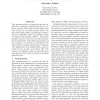Free Online Productivity Tools
i2Speak
i2Symbol
i2OCR
iTex2Img
iWeb2Print
iWeb2Shot
i2Type
iPdf2Split
iPdf2Merge
i2Bopomofo
i2Arabic
i2Style
i2Image
i2PDF
iLatex2Rtf
Sci2ools
COLING
2002
2002
Hierarchical Orderings of Textual Units
Text representation is a central task for any approach to automatic learning from texts. It requires a format which allows to interrelate texts even if they do not share content words, but deal with similar topics. Furthermore, measuring text similarities raises the question of how to organize the resulting clusters. This paper presents cohesion trees (CT) as a data structure for the perspective, hierarchical organization of text corpora. CTs operate on alternative text representation models taking lexical organization, quantitative text characteristics, and text structure into account. It is shown that CTs realize text linkages which are lexically more homogeneous than those produced by minimal spanning trees.
Alternative Text Representation | COLING 2002 | COLING 2008 | Quantitative Text Characteristics | Text Representation |
| Added | 17 Dec 2010 |
| Updated | 17 Dec 2010 |
| Type | Journal |
| Year | 2002 |
| Where | COLING |
| Authors | Alexander Mehler |
Comments (0)

